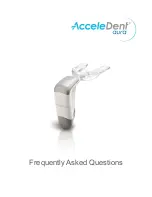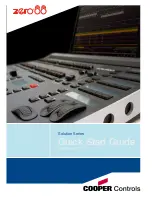
Installation instructions
1. Remove the unit from the packing box and inspect it for damage or imperfections. If any damage is found, do not
install the unit, but replace it carefully into the packing box and notify the ABB product support hotline in Australia on
1300 666 595.
2. If all looks okay, installation can proceed.
3. Remove the diffuser from the base.
4. Squeeze the gear tray retaining clips (2) to remove the gear tray from the base.
5. The Spitfire LED weatherproof batten can be either ceiling or wall mounted, or suspended. For wall or ceiling
installation; mark the position of the mounting brackets using the distance LF as shown in table below. Use the
mounting bracket as a template to mark mounting bracket screw locations.
6. Secure the mounting brackets (2) to the ceiling or wall using appropriate fixings (fixings suitable for installation
into concrete are supplied, for other mounting surfaces use appropriate fixings depending on the type of building
construction materials used).
7. There is 1 cable entry hole provided at 1 end of the base. If an alternate cable entry position is to be used, then drill
a hole to suit. Align the base to the installed mounting brackets and push the base to lock in onto the mounting
brackets.
Note:
To remove the base from the mounting brackets, rotate the gear tray retaining clips assembly a half
turn anti-clockwise. To refit the base, turn the retaining clips assembly a half turn clockwise.
8. Run mains cable as appropriate through the base access hole via a sealing grommet, gland or conduit. Ensure that
the IP rating of the luminaire is maintained.
Note:
If a sealing compound is used, it must be of the neutral cure type.
9. Attach the gear tray to the base via 2 lanyards and terminate the mains. Strip 9mm insulation length from mains cable,
connect and terminate wires to the terminal block. Be careful with multi-strand conductors that all the strands are
twisted together before insertion into the terminal. Any stray strands that inadvertently come into contact with their
neighbouring terminal will cause undesirable results when the fitting is powered.
10. Verify that the battery is connected to the power pack or PCA. For Nexus LX product; connect the data cable to the
power pack PCA. For Nexus RF product; fit the antenna connector to the hole provided in the base and then install
the antenna. For more details refer to the data connections section.
11. Energise the fitting and check for correct operation to ensure that the installation was successful. When powered up,
allow a few minutes to give the battery a small charge then press the test button on either Spitfire LED lamp head.
12. If the installation is successful, install the clips (8) to the base and clip on the diffuser as shown in figure 1. If required,
lock the clips using countersunk screws supplied in the bag.
Data connections - Nexus LX and Nexus RF product range
Important note: 24 hours is required to allow the fitting battery to reach full capacity, ie: prior to a discharge test.
As the installer, it is your responsibility to conduct the initial discharge testing of the installed fitting. Refer to
AS/NZS2293.
Removal instructions
1. Before removing the installed fitting, de-energise and lock off the supply circuit.
Note:
There may be 2 actives present,
ensure all power is isolated before proceeding.
2. Undo the retaining clips, remove the cover and unclip the gear tray from the base.
3. Unscrew the unswitched active, switched active, neutral and earth cable connection from the terminal block. For
Nexus LX unit; unplug the data cable connection from the terminal.
4. Disconnect the battery plug from the PCA.
5. Rotate the gear tray retaining clips assembly a half turn anti-clockwise to remove the base from the mounting
brackets.
Note:
When the fitting is reconnected to the supply, it will need time to recharge its battery for 24 hours before it will be
capable of a full length discharge again.
Fitting type/fitting state
Normal operation
Test switch pressed
(after few minutes charging)
Non-maintained
Lamp will be off
Lamps will illuminate
Maintained - with SA
Lamps follow the state of
the SA
Lamps will illuminate
irrespective of the SA State
Wire/fitting type
Non-maintained
Maintained - with SA
Switched active
Don’t wire SA terminal
Wire to SA terminal
Unswitched active
Wire to terminal A
Wire to terminal A
Neutral
Wire to terminal N
Wire to terminal N
Earth
Wire to terminal E or
Wire to terminal E or
Nexus LX fitting
Connect the data cable to the green connector on the power pack.
When correctly installed no fitting should have more than 2 data cables connected to it.
If you have more than 2 data cables at any 1 fitting, the installation is incorrect.
If this fitting is at the end of a data cable run, a terminator needs to wire in parallel across
the 2 data lines.
If there is an in and out data cable, then the shields should be wound together, folded back
and taped up.
Consult the Nexus user and technical guide for further detail, including product
commissioning.
Nexus RF fitting
Fit the antenna connector through the vacant hole on the gear tray and connect the
antenna to it as shown.
Collect the MAC address, by removing the peel off sticker section and locating it on your
floor plan or spreadsheet.
Note:
Other end of the antenna has been pre-connected to the power pack.
Consult the Nexus user and technical guide for further detail, including product
commissioning.
LF (mm)
Clip qty
L (mm)
W (mm)
H (mm)
905
8
1278
105
106
Fitting type
Indicator LED state - on initial powering - no fitting faults
Non-monitored
Solid red
Nexus LX
Flashing green
Nexus RF
Green flash with 2 red blinks, green flash with 3 red blinks
Figure 1:
Diffuser clip diagram
Antenna
Cable
Mounting
bracket
(supplied in
accessory
bag)




















